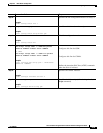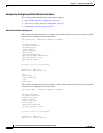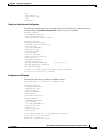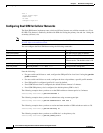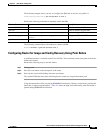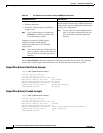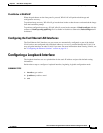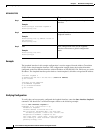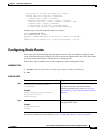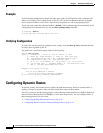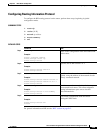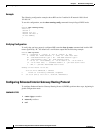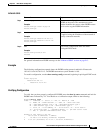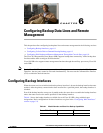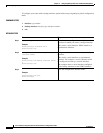
5-27
Cisco 819 Series Integrated Services Router Software Configuration Guide
OL-23590-02
Chapter 5 Basic Router Configuration
Configuring Static Routes
Output queue 0/0, 0 drops; input queue 0/75, 0 drops
5 minute input rate 0 bits/sec, 0 packets/sec
5 minute output rate 0 bits/sec, 0 packets/sec
0 packets input, 0 bytes, 0 no buffer
Received 0 broadcasts, 0 runts, 0 giants, 0 throttles
0 input errors, 0 CRC, 0 frame, 0 overrun, 0 ignored, 0 abort
0 packets output, 0 bytes, 0 underruns
0 output errors, 0 collisions, 0 interface resets
0 output buffer failures, 0 output buffers swapped out
Another way to verify the loopback interface is to ping it:
Router# ping 200.200.100.1
Type escape sequence to abort.
Sending 5, 100-byte ICMP Echos to 200.200.100.1, timeout is 2 seconds:
!!!!!
Success rate is 100 percent (5/5), round-trip min/avg/max = 1/2/4 ms
Configuring Static Routes
Static routes provide fixed routing paths through the network. They are manually configured on the
router. If the network topology changes, the static route must be updated with a new route. Static routes
are private routes unless they are redistributed by a routing protocol.
Follow these steps to configure static routes, beginning in global configuration mode.
SUMMARY STEPS
1. ip route prefix mask {ip-address | interface-type interface-number [ip-address]}
2. end
DETAILED STEPS
For general information on static routing, see the “Floating Static Routes” section on page B-5.
Command Purpose
Step 1
ip route prefix mask {ip-address |
interface-type interface-number
[ip-address]}
Example:
Router(config)# ip route 192.168.1.0
255.255.0.0 10.10.10.2
Router(config)#
Specifies the static route for the IP packets.
For details about this command and about
additional parameters that can be set, see
Cisco
IOS IP Routing: Protocol-Independent Command
Reference.
Step 2
end
Example:
Router(config)# end
Router#
Exits router configuration mode and enters
privileged EXEC mode.



